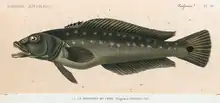| Pinguipes chilensis | |
|---|---|
 | |
| A depiction of Pinguipes chilensis in Le Règne Animal (Georges Cuvier). | |
| Scientific classification | |
| Domain: | Eukaryota |
| Kingdom: | Animalia |
| Phylum: | Chordata |
| Class: | Actinopterygii |
| Order: | Trachiniformes |
| Family: | Pinguipedidae |
| Genus: | Pinguipes |
| Species: | P. chilensis |
| Binomial name | |
| Pinguipes chilensis Valenciennes, 1833 | |
| Synonyms[1] | |
|
Pseudopercis chilensis (Valenciennes, 1833) | |
Pinguipes chilensis, commonly known as the Chilean sandperch, is a species of ray-finned fish in the family Pinguipedidae. It is found in the southeastern Pacific Ocean off the coasts of Peru and Chile.[1][2]
Description
P. chilensis can grow to a maximum length of 51 cm (20 in). The dorsal fin has six spines and twenty-eight soft rays, and the anal fin has a single spine and twenty-five soft rays.[2] A specimen caught by Charles Darwin during the Beagle voyage was described as being more elongated than Pinguipes brasilianus, being about six and a half times as long as the body is deep and as having two longitudinal rows of ill-defined spots on the flanks and a larger, dark-coloured, round spot at the base of the caudal fin.[3]
Distribution and habitat
P. chilensis is found in the southeastern Pacific Ocean. Its range extends from Tumbes in northern Peru, southwards to the Magallanes Region of southern Chile. It is found on muddy bottoms as well as on rocks and sand, to depths of 100 m (330 ft).[2] It is also present in the kelp forest alongside other carnivorous fish such as the Peruvian morwong (Cheilodactylus variegatus), the sea chub (Graus nigra) and the Cape redfish (Sebastes capensis).[4]
Ecology
P. chilensis is a generalist predator, its diet consisting mainly of crustaceans, with smaller quantities of fish and polycheate worms; less often eaten are molluscs, brittle stars, sea urchins, proboscis worms, peanut worms, spoon worms and tunicates. Small fish (less than 30 cm (12 in) long) fed largely of the amphipod Ampelisca araucana while medium size fish mostly took mysids such as Neomysis sp. The largest fish (over 40 cm (16 in) long) mostly preyed on other species of fish, worms, molluscs and sea urchins. The diet also varies according to the time of year and the seasonal availability of prey species, with more fish being taken in the autumn.[5] This fish is oviparous, with spawning taking place in the spring.[6]
References
- 1 2 Bailley, Nicolas (2015). "Pinguipes chilensis Valenciennes, 1833". WoRMS. World Register of Marine Species. Retrieved 2 July 2018.
- 1 2 3 "Pinguipes chilensis Valenciennes, 1833". FishBase. Retrieved 2 July 2018.
- ↑ Jenyns, Leonard (1842). Darwin, Charles (ed.). The Zoology of the Voyage of H.M.S. Beagle Under the Command of Captain Fitzroy, R.N., during the Years 1832 to 1836. Vol. Part IV. Fish. London: Smith, Elder & Co. pp. 22–23. doi:10.5962/bhl.title.14216 – via archive.com.
- ↑ Gibson, R.N.; Atkinson, R.J.A.; Gordon, J.D.M. (2007). Oceanography and Marine Biology: An Annual Review. CRC Press. p. 241. ISBN 978-1-4200-5094-3.
- ↑ González, P.; Oyarzún, C. (2003). "Diet of the Chilean sandperch, Pinguipes chilensis (Perciformes, Pinguipedidae) in southern Chile". Journal of Applied Ichthyology. 19 (6): 371–375. doi:10.1111/j.1439-0426.2003.00444.x.
- ↑ Rosa, lerecê L.; Rosa, Ricardo S. (1997). "Systematic revision of the South American species of Pinguipedidae (Teleostei, Trachinoidei)". Revista Brasileira de Zoologia. 14 (4). doi:10.1590/S0101-81751997000400009.